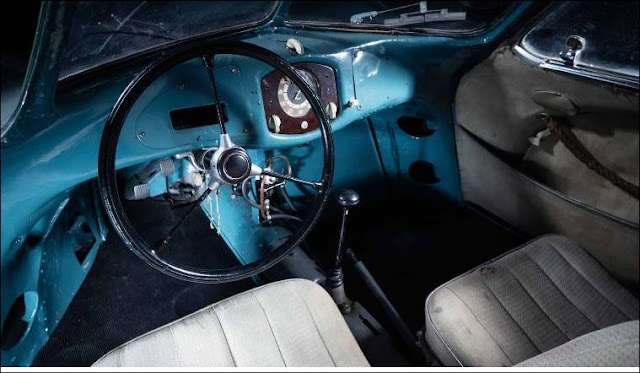The Porsche 911's great grandfather is going up for auction this summer and it could well be the most valuable car ever sold with the Porsche name on it.
The Porsche Type 64 looks a little like a child's clay model of a modern Porsche. It was Ferdinand Porsche's early attempt at a sports car with the engine in the back. This was the same basic idea the Porsche car company would use in its first car, the 356, and later in the 911.
"If you put anybody with passing knowledge of automobiles in front of that car and asked them what it was, they would probably say 'Porsche,' because it's really pretty obvious," said Leslie Kendall, curator at the Petersen Automotive Museum in Los Angeles.
The car will be put up for auction by RM Sotheby's in mid-August in Monterey, California.
As the earliest Porsche sports car, and with a direct lineage to today's 911s, it could be worth $20 million to $25 million, according to experts at Hagerty, a company that insures collectible cars. That would make it the most valuable Porsche ever sold. There's no record of a Type 64 being auctioned before, according to Hagerty, and, given the car's uniqueness, estimating its value is difficult.
The highest price ever paid for a Porsche at auction up to now was $14 million paid in 2017 for a 1970 Porsche 917 race car used in the Steve McQueen movie Le Mans.
The Type 64 was based on one of Ferdinand Porsche's earlier designs, the KdF-Wagen. The Kraft-durch-Freude-Wagen (which translates to "strength through joy car") was supposed to be an inexpensive automobile for German families, something the Nazi government could celebrate as an achievement for its people. It never went into large scale production during the Nazi era but, after the war, it would become known as the Volkswagen Beetle.
Porsche saw the potential for a racing car based on the KdF-Wagen's rear-engined design. Having the engine in the back put weight over the wheels that propelled the car, helping with traction when on slippery roads and while accelerating. In the hands of a skilled driver, a rear-engined car could also take tight turns without the weight of an engine up front pulling the car's nose outwards. Of course, it did tend to pull the tail outwards and could make the car spin around, one of the inherent hazards of this type of design.
The first Type 64 was built to compete in a Berlin to Rome road race scheduled for September, 1939. Its chassis and engine were borrowed from the KdF-Wagen, but the engine was altered slightly, boosting its output to 32 horsepower. That was a respectable figure for a car of its size and weight at the time. Aircraft construction technologies were used to make the lightweight alloy body.
On September 1, 1939, German armed forces invaded Poland, sparking World War II. The Berlin-Rome race never happened. The factories that were to have built KdF-Wagens for German families were given over to producing Porsche-designed military vehicles instead. Only one Type 64 had been built by this time, but a second was completed later.
The one being auctioned was, technically, the third car, but it was built on the frame of the first after it had been crashed by a Nazi-era Volkswagen executive. The second Type 64 was confiscated by Allied forces after the war and crashed soon after. It was later rebuilt and is now on exhibit at a museum in Hamburg, Germany, after spending some time at the Petersen Museum.
The Porsche family was allowed to keep this particular Type 64 and it was driven extensively by both Ferdinand and his son Ferry, who would later create the 356. Ferry applied the family name to the front of the car. In 1947, this Type 64 was restored by the Turin, Italy, auto design and manufacturing firm known today as Pininfarina.
Source By edition.cnn.com





Post a Comment
Post a Comment